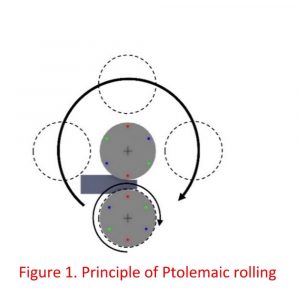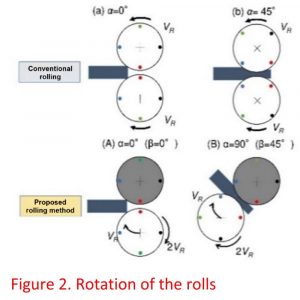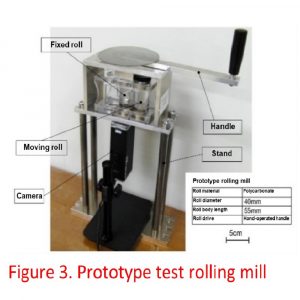Rolling condition observation device and rolling condition observation method
March 8, 2023
Background / Context / Abstract:
Most basic metallic materials such as plates, foils, bars, wires, and tubes are industrially produced by rolling. Rolling is a plastic working method to decrease the thickness and increase the length by passing the workpiece between a pair of rolls rotating in opposite directions to each other. The two rolls continue to rotate without coming to rest, making it possible to produce long materials continuously at high speed.
The workpiece enters the roll bite (roll contact) at a velocity lower than the roll peripheral velocity and is discharged at a velocity higher than the roll peripheral velocity due to the roll friction force.
Therefore, during the roll bite, the relative velocity of the workpiece to the roll peripheral velocity changes direction and the direction of the frictional shear stress changes at the neutral point where the velocity of the workpiece and the roll peripheral velocity coincide. As a result, the deformation of the workpiece at the contact with the roll and the phenomenon at the interface between the roll and the workpiece are complicated.
Technology Overview:
In the rolling process, a lubricant is used to reduce the rolling load and torque as well as to obtain a smooth surface. The type and viscosity of the lubricant, and the amount and method of application are important, and the choice is largely based on experience. The lubricant is drawn hydrodynamically by the rotating rolls and exists as a film at the interface between the roll and the workpiece under high pressure. Therefore, the film thickness is expected to depend on the rotation velocity of the rolls and the degree of machining, but since the rolls are rotating at high speed, the lubrication state at the rolling interface has not been observed and the lubricant film thickness has not been measured. It is also difficult to measure the surface pressure applied to the rolls and the shear stress during rolling.
The present invention provides a method for observing the state of the rolling interface during rolling in order to solve the above problems. The greatest feature of the said rolling method is that one of the rolls is placed in space without rotation or revolution. If the revolution velocity of the moving roll is set to twice the rotation velocity, it is kinematically shown that the relative motion of the workpiece and the rolls coincides with that of conventional normal rolling. In that case, the fixed roll is fixed in space, not rotating or revolving, and therefore, it is possible to incorporate various sensors in this fixed roll to make measurements continuously during rolling, which enables measurements not possible with conventional methods.
Benefits:
In the prototype test rolling mill, the frame has a double structure in which the fixed roll is fixed to the outer frame, and both remain stationary without rotating during rolling. The moving roll is installed in the inner frame and revolves around the fixed roll by manually turning the inner frame around the axis of the fixed roll. The moving roll is connected with the fixed roll via a gear, and is structured to rotate as well as revolve. The workpiece is then rolled in the gap between the fixed roll and the moving roll while rotating around the fixed roll. In the prototype mill, the rolls are made of transparent polycarbonate, and through a reflector inside the fixed roll, the motion of the workpiece is measured, and the state of the rolls and workpiece interface is observed successfully during rolling.
Potential Applications / Potential Markets:
To manufacture a large-sized rolling condition observation device to elucidate rolling phenomena under industrial conditions and to achieve the following challenges.
(1) Development of rolled materials with controlled surface properties by elucidating the behavior of surface properties of the rolled materials
(2) Development of lubricants by elucidating the behavior of rolling lubricants
(3) Design of rolling mills and development of control software
State of Development / Opportunity / Seeking:
・Available for exclusive and non-exclusive licensing
・Exclusive/non-exclusive evaluation for defined period (set up for options)
・Collaborative/supportive research
※Seeking
1. Development partner
2. Licensing
IP Status:
PCT applied in Japanese
Figures:
Contact:
![]()


